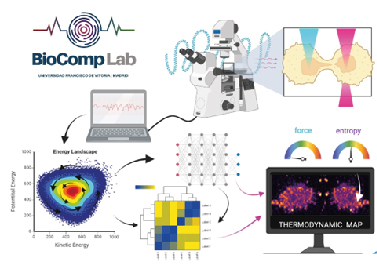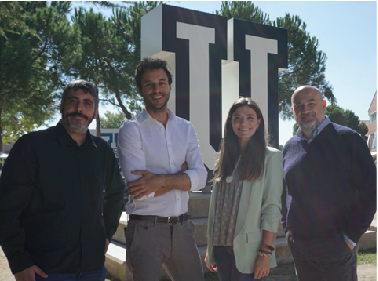COMPUTATIONAL BIOPHYSICS AND BIOLOGICAL DATA ANALYSIS
COMPUTATIONAL BIOLOGY AREA
Group coordinator
Dr. Diego Herráez Aguilar | diego.herraez@ufv.es
Researchers
- Dr. Ramiro Perezzan Rodríguez
- Dra. Sandra Montalvo Quirós
- Carlos del Pozo Rojas (Industrial Engineer and student of the University Degree in Pharmacy)
External collaborating researchers
- BIOPHYS-Hub. Department of Physical Chemistry, Faculty of Chemical Sciences. Universidad Complutense de Madrid and Translational Biophysics Unit, Instituto de Investigaciones Biomédicas del Hospital 12 Octubre, Madrid (PI: Dr. Francisco Monroy)
- Neurorehabilitation and Brain Damage Group. Biosanitary Research Institute. Universidad Francisco de Vitoria (PI: Juan Pablo Romero).
- Botany and Applied Pharmacognosy Group. Biosanitary Research Institute. Universidad Francisco de Vitoria (PI: Lourdes Rufo)
- Cell and Gene Therapy Unit, Hospital Niño Jesús de Madrid (PI: Dr. Manuel Ramírez)
- Disease, Infection and Tolerance Group, Faculty of Veterinary Medicine, Universidad Complutense de Madrid (PI: José M Bautista)
Research Summary
Since its inception, the Computational Biophysics group has devoted its efforts to the development and (experimental) validation of algorithms for the detailed analysis of biodata, paying special attention to the extraction of physical properties of the analyzed systems. The algorithms built cover a wide spectrum of purposes: time series analysis, entropy computation, advanced statistics, classification systems, cluster analysiss, image processing , cell phenotyping, cell counting, fluorescence quantification, dynamics of cellular intramotions, thermodynamic microscopy, etc. These techniques are currently being used for the microreological analysis of intracellular media, description of cell mechanics and thermodynamics, as well as in the determination of the effect of energy injection on interfaces (membranes).

An example of this has been the development of biomarkers for childhood acute lymphoblastic leukemia based on biomechanical properties of cell nuclei. The idea of using physical properties of intracellular media as an estimator of the cellular metabolic status was published in the journal Scientific Reports. In addition, the group received, in 2022, funding from the Spanish Ministry of Science and Innovation for the fine-tuning of this and other associated techniques in larger scale studies.
A second parallel line of research is the study of the effect of energy injection on intracellular media, paying special attention to membranes and interfaces. Energy injection, which usually occurs as a direct consequence of metabolism, induces generalised changes in the mechanical properties of the media in which life develops; these changes range from the ordering of the system, to the reduction of viscous dissipation, to the softening of the media or to the appearance of mechanisms of matter and energy transfer (transport of matter, convective phenomena, entropy production, etc.). However, one of the main consequences of energy injection on the system is the improvement of the efficiency of thermodynamic processes. That is, the energy reduces the randomness of the system allowing the existence of biological clocks.
All these derivatives are currently being considered in the study of the mechanical properties of erythrocytes, with an in-depth study of the influence that energy modulators exert on their properties.
Finally, since 2019, the group has embarked on the estimation of brain entropy production through the analysis of electroencephalography signals. This line of research, which is being developed in collaboration with the Neuromodulation and Neurorehabilitation group (UFV), aims to develop evolutionary biomarkers for different neurodegenerative diseases. For this purpose, computational techniques and analyses based on information theory and statistical mechanics are being used.
Research lines
- Computational biophysics: Computational analysis of biological systems and stochastic simulation.
- Experimental biophysics and cellular mechanics. Microrheology, cell morphology and flickering spectroscopy.
- Computational microscopy: development of algorithms for advanced microscopy image analysis.
- Development of advanced biodata analysis algorithms.
- Development of markers based on entropy estimators.
- Modeling and 3D printing of biomolecules
- Design and characterisation of nanomaterials for application in biomedicine.
- Cell studies: metabolism, cell cycle, cell viability, morphological modifications.

Projects in the last 5 years
- Integrative cellomics for precision medicine in Leukemia: A coordinated eHealth action for the biodigitalization of cancer (LEUKODOMICS). PI: Diego Herráez-Aguilar. Funding Entity: Ministry of Science and Innovation (2022-2024)
- Out-of-equilibrium dynamics of intracellular media. PI: Diego Herráez-Aguilar. Funding Entity: Universidad Francisco de Vitoria (2022-2023)
- Thermodynamics of the cell: an encounter of biology with the Action Principle. Universidad Complutense de Madrid. PI: Francisco Monroy Muñoz. Funding Entity: Ministry of Science and Innovation (2020-2023)
- SYNERGY CAM 2018 NUCLEUX MADRID Y2018/BIO 5207 Project. Universidad Complutense de Madrid. PI: Francisco Monroy Muñoz. Funding Entity: Comunidad de Madrid (2019-2021)
Publications
- Erythroid SLC7A5/SLC3A2 amino acid carrier controls red blood cell size and maturation. A. Bouthelier, L. Fernández-Arroyo, D. Herráez-Aguilar, F. Monroy, J. Aragonés et al. iScience, 2022, 26, 105739
- Lipid nanoparticles for antisense oligonucleotide gene interference into brain border-associated macrophages. M Calero, L H Moleiro, A Sayd, D Herráez-Aguilar, T Hellweg, L Sánchez, A Bortolozzi, B García-Bueno, F Monroy. Frontiers in Molecular Biosciences, 2022, 9, 887678
- Moulding hydrodynamic 2D-crystals upon parametric Faraday waves in shear-functionalized water surfaces. Mikheil Kharbedia, Niccolò Caselli, Diego Herráez-Aguilar, Horacio López-Menéndez, Eduardo Enciso, José A. Santiago and Francisco Monroy. Nature Communications, 12, 1130, 2021
- Time series analysis applied to EEG shows increased global connectivity during motor activation detected in PD patients compared to controls. R. Perezzan, A. Maitín, D. Herráez-Aguilar, J.I. Serrano, M. Dolores Castillo, A. Arroyo, J. Andreo, J.P Romero Muñoz. Appl. Sci. 11, 15, 2021
- Mesoporous silica nanoparticles containing silver as novel antimycobacterial agents against Mycobacterium tuberculosis. Sandra Montalvo-Quiros; Sergio Gómez-Graña; María Vallet-Regí; Rafael C. Prados-Rosales; Blanca González; Jose L. Luque-Garcia. Colloids and Surfaces B: Biointerfaces,197, 111405, 2021
- Multiple particle tracking analysis in isolated nuclei reveals the mechanical phenotype of leukemia cells. D. Herráez-Aguilar, E. Madrazo, H. Lopéz-Menendez, F. Monroy, J. Redondo-Munoz. Scientific Reports, 10, 6707, 2020
- Mesoporous Silica Nanoparticles as a Potential Platform for Vaccine Development against Tuberculosis.Pharmaceutics . Sandra Montalvo-Quiros; María Vallet-Regí; Ainhoa Palacios; Juan Anguita; Rafael C. Prados-Rosales; Blanca González; Jose L. Luque-Garcia.,1, 1. Multidisciplinary Digital Publishing Institute
- Influence of spatial filtering on EEG signal stichasticity measurements in Parkinson’s Disease. D Herraez-Aguilar, A Maitin, R Perezzan, D Del Castillo, I Serrano, E Rodriguez, E Rocon, A Arroyo, J Andreo, J Romero. Movement Disorders, 34 S360-361, 2019
- Cancer cell targeting and therapeutic delivery of silver nanoparticles by transferrin decorated mesoporous silica nanocarriers: insights into the action mechanisms by quantitative proteomics. Sandra Montalvo-Quiros; Guillermo Aragoneses-Cazorla; Laura Garcia-Alcalde; María Vallet-Regí; Blanca González; Jose L. Luque-Garcia. Nanoscale,11, 4531, 2019
- Combination of bioanalytical approaches and quantitative proteomics for the elucidation of the toxicity mechanisms associated to TiO2 nanoparticles exposure in human keratinocytes. Sandra Montalvo-Quiros; Jose L. Luque-Garcia. Food and Chemical Toxicology, 127, 197, 2019.
- Experimental and theoretical studies of the Xe–OH (A/X) quenching system. j Kłos, G McCrudden, M Brouard, T Perkins, SA Seamons, D. Herráez-Aguilra, F. J. Aoiz. The Journal of Chemical Physics, 149, 184301, 2018.
- Development of a thiourea derivative polymer combined to a Direct Mercury Analyser for screening and pre-concentration of mercury species. Sonia Zarco Fernández; Sandra Montalvo Quirós; María Jose Mancheño; Carmen Cámara; Riansares Muñoz Olivas. Talanta. 162, 612, 2017 BH 9-8*7/*/+
- Quantum interference between H + D2 quasiclassical reaction mechanisms. PG Jambrina, D Herráez-Aguilar, FJ Aoiz, M Sneha, J Jankunas, RN Zare. Nature Chemistry, 7, 661, 2015.
